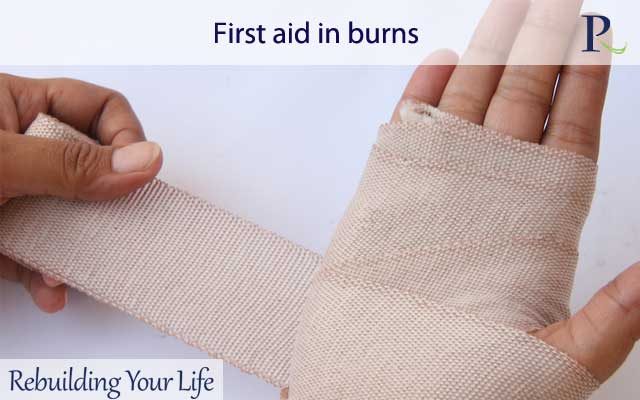Burns are quite common and can be caused by multiple factors: electricity, chemicals, fire, etc. It is important to know how to act quickly and how to treat a possible burn.
Contact with any source of heat can cause a burn or scald injury. A burn can result from contact with a heat source such as hot metal or electricity, hot liquid or steam. Clothing over the area may retain the heat and cause further injury.
What to do if you experience a burn?
It happens quite often that you suffer a burn right at home. But do you know how to give first aid in burns? These can be easy and easy to heal, but if they occur on large areas, they can be life-threatening. It is very important to have the necessary knowledge to intervene quickly if this type of accident occurs in your own home.
What you should do when your child , your loved one, a friend or even you gets a burn depends on how severe the burn is. Simply put, there are three levels of burns; knowing how to treat each of them quickly and efficiently is crucial.
- First degree. The skin turns red, but it does not blister. It is somewhat painful, like a sunburn.
- Second degree. The outer layer of skin is burned, and some part of the dermis is damaged. The burn will be very painful and will likely develop blisters.
- Third degree. The skin will be charred or white. The epidermis and dermis (top two layers of skin) are irreversibly damaged.
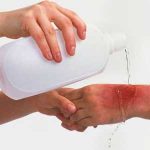 First aid in first degree burns
First aid in first degree burns
- Keep the affected area under very cold water, 5-10 minutes.
- Disinfect the area and apply a special cream or spray against burns.
- Bandage with a clean gauze.
First aid in second degree burns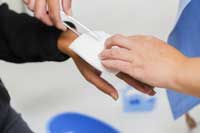
- Keep the affected area under cold water for as long as possible, up to 30 minutes, to ensure the temperature drops. This prevents deeper tissue damage.
- Bandage with a sterile bandage, without tightening the material on the skin. This will create a pleasant sensation and help relieve pain.
- Avoid the bath or shower on the injured side.
- If the pain intensifies, you can take a mild analgesic of the ibuprofen type.
- Do not try to break the vesicles, because you will create an environment favorable for infections.
First aid in third-degree burns
And this kind of burn can occur on any part of the body, but it is not advisable to take care of it at home. Get to the emergency room and consult your doctor, who will take care of: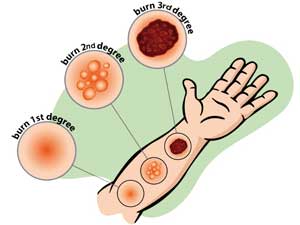
- Removing fragments of clothing from the burned area and cleaning the wound deeply.
- Constant checking of vital signs, breathing, circulation and pulse.
- Wound bandage and application of special solutions.
- Clothing that caught fire
First aid in burns by applying ointment
It is advisable to place the victim down, rolling it several times to put out the flames, or covering it with a blanket. Being deprived of oxygen, the flame will go out quite quickly. You can try to remove burnt clothes only if they are not glued to the skin, especially in the case of synthetic materials.
Electric burns
After inactivating the power source, keep the area burned under cold water for a few minutes, during which time you can try to remove the textile debris. Place a sterile gauze on the wound and transport the victim to the hospital immediately. Electrocution can cause much more serious problems, in addition to burns.
Chemical burns
Any area of the body would be affected, rinse with plenty of water, without soap, as it could interact with the chemicals on the skin. Visit your doctor for specialist treatment.
 What NOT to do in case of a burn
What NOT to do in case of a burn
- Do not put ice directly on burnt skin, as this can cause frosts that worsen the situation.
- Do not apply common lotions or oils, which are not indicated for such situations. These could affect the healing process.
- In no way does the blister formed break, there is a high risk of inflammation.
- It is forbidden to use patches or wool on damaged skin. These objects do not allow the skin to breathe and can lead to infections.
- Do not remove any scraps of clothing that have stuck to the skin because they can detach completely with the superficial layer of skin. A doctor will apply the right methods.
- As far as possible, it does not touch wounds and burns, to prevent contamination.
- Never apply to the skin burnt toothpaste, animal fat, talcum powder or body cream, as they worsen the situation and the healing process.
Handy solutions for light burns
 Aloe Vera
Aloe Vera
First aid in burns by applying aloe Vera
Aloe Vera gel has anti-inflammatory properties that accelerate the healing process of wounds and burns.
You can apply the gel directly from the leaf of the plant, for instant pain relief.
 Honey
Honey
Honey is a universal panacea, with multiple antibacterial, antibiotic and anti-inflammatory properties, being the ideal remedy for a mild burn.
Apply directly to the wound and repeat several times a day.
 Yellowing extract
Yellowing extract
Yellowing oil is an excellent antiseptic and analgesic, helping to cure any skin conditions faster.
You will find the yellowish extract in any of the creams in the form of cream, gel, lotion or oil, so you can choose the one that best suits you.
Remedies in case of burns, unnecessary or harmful
- Lemon juice. It is not alright, and it won’t help; it is not repairable. In contrast, in contact with sensitized nerve endings, it causes a lot of itching.
- Medicinal alcohol. Like lemon juice, it will produce great garlic. And if I suffered a chemical burn, it could get worse. Substances have a habit of reacting with each other.

- Yogurt can contain a lot of bacteria that are waiting so long. Due to the partially destroyed skin, they have a clear path to the tissue beneath the skin and the infection is as safe.
- Olive oil is not moisturizing; it is only slightly emollient. You have nothing to do with it except in the healing phase, when the skin remains rough.
- Ointments of all kinds, when the skin is destroyed. If the protective barrier no longer works, contact with any non-sterile substance can lead to infection.
How do you realize the severity of the burn?
 By color. If it is red, it means that blood is circulating alert in the affected area. If it is rather white, it means that the blood vessels near the surface – the capillaries – are destroyed. In this case, the burn is worse.
By color. If it is red, it means that blood is circulating alert in the affected area. If it is rather white, it means that the blood vessels near the surface – the capillaries – are destroyed. In this case, the burn is worse.- After elasticity. If you press, the place should whiten and deepen. After release, it must return to form and color. If it does not return, it means that the tissue has lost its elasticity, so it is severely affected.
- After sensitivity. Paradoxically, if you grieve, that’s fine. It is a sign that the nerve endings have escaped alive and are reacting. If you do not feel itchy, it means that some nerve endings have been destroyed.
- By skin condition. If the skin has not detached, or raised and formed a pustule, there is a great chance of natural healing. If the pustule is broken or not formed, if you see the meat directly, the burn is serious.
- After the affected surface. Even if it doesn’t look too deep, the burns on the large surface pose specific problems. It is difficult to manage. Washing, dressing, sitting and sleeping will be difficult for a while. Also, monitoring the evolution is more difficult.
Keep in mind !
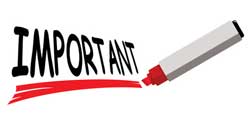 In the face of a burn victim, it must be acted upon as in front of a traumatized person, as it can often have much more serious organic damage than the skin surface injury. For example, in the event of a fire, victims may present with skin burns and CO poisoning or injuries caused by smoke inhalation.
In the face of a burn victim, it must be acted upon as in front of a traumatized person, as it can often have much more serious organic damage than the skin surface injury. For example, in the event of a fire, victims may present with skin burns and CO poisoning or injuries caused by smoke inhalation.
Therefore, the first gesture will be the evaluation of vital functions and if cardio-respiratory resuscitation is needed and only then will burns be evaluated.
Accidents indeed can happen even if we try to always be careful . So, this mini-guide I hope it will help you if anything similar occurs.
Remember, however, that you can safely treat, without specialized help, only superficial burns, which do not exceed the size of the affected hand. Those who go beyond these dimensions and are deeper in need of emergency medical care to avoid complications.
Other helpfull resouces:
- How To Treat A Burn: First Aid Treatment for Thermal Burns

